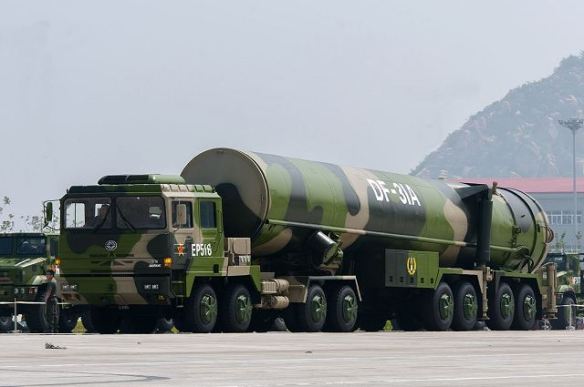DF-31A intercontinental ballistic missile ICBM at military parade of September 3, 2015
The new DH-10 LACM poses a serious threat to US and allied naval vessels in the western Pacific.
Chinese sources report the ground launched CJ-10 to be the GLCM variant of the DH-10 design, carried on a three round TEL.
The “renegade province” of Taiwan figures perhaps most prominently, with China developing core military capabilities around an ability to attack the island. By December 2009, the PLA was fielding 1,050-1,150 DF- 15 and DF-11 short-range ballistic missiles (SRBM) opposite Taiwan, plus the much more potent DF-21C medium-range ballistic missile (MRBM). Fortunately, relations with Taiwan improved after the 2008 election of President Ma Yingjeou. China also realises the necessity of countering Taiwanese allies like the US, who would likely come to the island’s aid in the event of hostilities. The US is unwavering in its commitment to a $6.5 billion Taiwanese arms package announced in 2008, which includes Apache AH-64D helicopters, Patriot Advanced Capability (PAC-3) and Harpoon missiles. This deal enraged China, causing an immediate suspension of military ties with the USA. China pursues a policy of “active defence,” and although not bent on global domination, its rising influence will inevitably increase tensions with the world’s solitary superpower. This jostling was amply illustrated in March 2009 when the USNS Impeccable surveillance ship was harassed in the South China Sea.
Increasingly accurate area denial/anti-access weapons, and missiles able to target assets such as aircraft carriers in the Pacific, are worrying the USA. China is developing its strategic missile inventory more rapidly than any other country. Credible reports state China is currently deploying or developing five different ICBM types. While China advocates a policy of no-first-use of nuclear weapons, its 11,000Km-range DF-31A is capable of targeting Washington DC. This three-stage solid-propellant ICBM can carry a single 1,000ktyield nuclear warhead, and it has become a harder target now that it is truck-and-trailer mounted. Smaller in size is the 1,700Kmrange DF-21C MRBM launched from a 10×10 transporter-erector-launcher (TEL) vehicle. The DF-15C SRBM mounted on an 8×8 TEL has a 600km range. It is difficult to comment on the performance of Chinese tactical and strategic missiles as they have not been subjected to complex combat conditions, but it is patently clear that their sophistication and quantity is swiftly growing.
A major revelation at the 60th anniversary parade was the DH-10 land attack cruise missile (LACM). The USA estimates China had deployed 200-500 of this Tomahawk-like weapon by the end of 2009. Warheads include nuclear and conventional HE, with electromagnetic pulse (EMP) a future possibility. The USA believes China is poised to field the world’s first anti-ship ballistic missile (ASBM), which will pose a huge threat to the US Navy’s Pacific Fleet with its range exceeding 1,500km. Identified by US naval intelligence as the DF-21D (reflecting its DF- 21 MRBM lineage), it can be fired from mobile land-based launchers.
